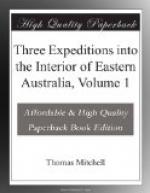June 24.
We possessed nearly west over open ground skirted on the south by gentle eminences of red earth. There plains of soft naked soil were most distressing to the bullocks, and even to horses and men on foot; in the general direction of the river these plains extended to the horizon, but the southern boundary of small hills was a peculiar feature, not observed higher up. Though the base of these eminences consisted of fine blue clay, yet their tops were so sandy and soft that the carts sank deeper than on the plains. It was my study to keep along the side of these hills as much as my route would permit; for in general the best line for travelling through the valley of the Darling is along the edging of stiff clay always to be found near the base of the red sandhills, which form the limits of those softer plains that usually extend for several miles back from the river.
MACCULLOCH’S RANGE.
On ascending the highest of the hills on my left I discovered that the ground to the southward was much more broken, and the appearance of a valley between me and a range which I named after Dr. Macculloch raised my hopes of finding some change in the country. On ascending however another eminence to the right, I perceived the summit of a hill which bore west-north-west, and rather discouraged my hopes respecting the river, for I had assumed that its new direction towards the westward would continue. We crossed the hill and encamped about two miles to the southward of a bend of the river. Here there was a fall of about four feet over masses of ferruginous clay with selenites embedded.* The banks were lower at this point than usual, and the quantity of running water was rather increased, probably from the springs which we had latterly observed in great abundance in the banks, generally about two feet above the surface of the stream. On the plains this day we found much selenite.
(Footnote. This clay, in the opinion of geologists, has every appearance of a mud deposit.)
June 25.
There was again a considerable mirage or refraction this morning on the rising of the frost; and I hastened to a small hill near our camp that I might behold the transient vision of a distant horizon. The view was most interesting for the high lands on all sides appeared raised as if by magic; and I thus discovered that the hill, previously seen in the west, was connected with a chain which extended round to the north, and that there was higher land to the southward of Macculloch’s range; the highest point being to the east, or east-north-east, beyond the hill discovered on the 21 instant. The horizon was lowest towards the west-south-west, for even in the south-west I could perceive a rise sufficient to confine the course of the river to the west-south-west. We proceeded nearly west by south over a soft bed of naked earth, across which, at one place, a well-beaten road of the natives led to the valley on the south and to some watercourse, if not to water itself. After 10 1/4 miles of weary travelling, we encamped on a bend of the Darling, in latitude 31 degrees 31 minutes 20 seconds South.




